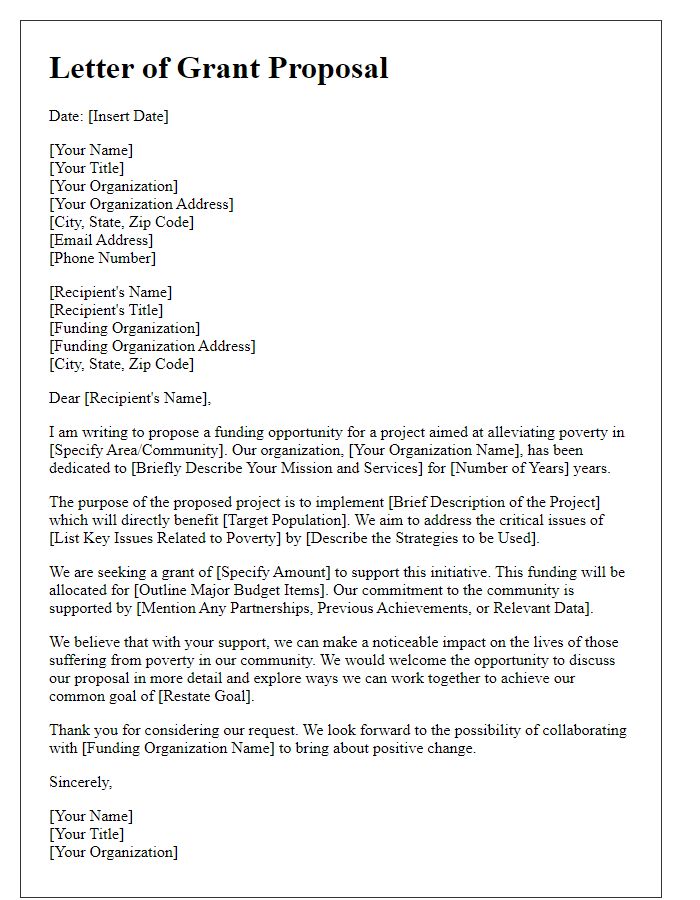Are you looking to make a meaningful impact in the fight against poverty? Writing a letter to request sponsorship for poverty alleviation can be a powerful way to engage potential supporters and share your vision. In this article, we'll guide you through creating a compelling sponsorship request that highlights the urgent need for help and the positive changes their support can bring. So, grab your pen, and let's get started on crafting a letter that resonates and inspires action!

Alignment with Sponsor's Mission
Poverty alleviation initiatives require strategic alignment with sponsor missions to maximize impact. Organizations like the Bill and Melinda Gates Foundation, dedicated to reducing global poverty, often seek partnerships that resonate with their values. Targeting low-income communities in regions such as Sub-Saharan Africa (where over 400 million people live on less than $1.90 a day), sponsorship requests should highlight how proposed projects contribute to sustainable change. Emphasizing measurable outcomes, such as increased access to education (where only 62% of children complete primary school), ensures alignment with sponsors' objectives. Additionally, showcasing collaboration with local NGOs can enhance credibility and demonstrate a commitment to grassroots empowerment, further attracting sponsor interest in poverty alleviation efforts.
Clear Objectives and Impact
Clear objectives for poverty alleviation include increasing access to basic needs such as food, education, and healthcare in underprivileged communities. Specific initiatives involve establishing community gardens to provide nutritious food, creating scholarship programs to support education for children's futures, and partnering with local health clinics to improve medical access. Impact metrics can be measured through improved school attendance rates, reduced malnutrition levels, and enhanced health outcomes in targeted areas. For example, a sponsorship of $10,000 could facilitate the education of 50 children, improve community health services, and provide food security to over 200 families. Such contributions not only address immediate needs but also empower individuals and families, fostering long-term sustainable development.
Budget Transparency
Budget transparency in poverty alleviation programs is crucial for ensuring effective utilization of resources. Detailed financial reports (including projected expenses, fund allocation, and actual expenditures) enable stakeholders to track how funds are distributed across various initiatives. Clear breakdowns (for example, administrative costs, direct aid, and community development projects) allow for informed assessments of efficiency and impact. Public access to this financial information fosters accountability, motivating sponsors and donors to support projects with demonstrable outcomes (like increased access to education, healthcare, or employment opportunities). Involving local communities in budget discussions can enhance understanding of needs and priorities, ultimately leading to tailored solutions that effectively address poverty.
Sustainable and Long-term Solutions
Poverty alleviation programs aim to provide sustainable and long-term solutions for marginalized communities, emphasizing the need for comprehensive strategies that address root causes. Initiatives often include skills development and vocational training (empowering individuals to secure stable employment) and microfinance (enabling access to small loans for entrepreneurs). Local partnerships with non-governmental organizations (NGOs) play a crucial role in executing tailored programs that consider specific community needs. Community gardens promote self-sufficiency and food security, while educational support for children paves the way for future opportunities. Long-term investment in infrastructure projects enhances access to clean water and healthcare services, ultimately lifting families out of poverty and fostering economic growth over time.
Success Metrics and Reporting
Poverty alleviation programs require robust success metrics and transparent reporting to ensure accountability and effectiveness. Key metrics include the number of beneficiaries served, which may exceed 10,000 individuals annually in targeted communities such as rural areas in Sub-Saharan Africa. Tracking educational outcomes, such as an increase in literacy rates by 20% following program implementation, provides measurable impact. Employment statistics reflecting job placements, which could reach 1,500 placements annually, further demonstrate success. Regular reports, detailing financial expenditures against budget forecasts, enhance transparency, ideally provided on a quarterly basis. Incorporating beneficiary testimonials and case studies enriches narratives, showcasing personal success stories that humanize the statistics and illustrate the program's real-world impact. Engaging stakeholders through quarterly impact webinars ensures ongoing dialogue and fosters a sense of community.
Letter Template For Poverty Alleviation Sponsorship Request Samples
Letter template of sponsorship appeal for poverty alleviation initiatives

Letter template of partnership request for community upliftment programs

Letter template of donor solicitation for socio-economic development projects

Letter template of support request for underprivileged community services

Letter template of collaboration inquiry for economic empowerment initiatives









Comments